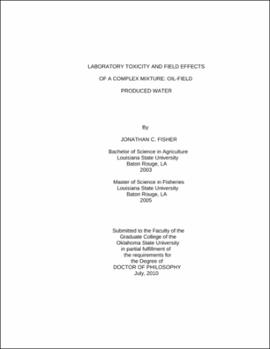| dc.contributor.advisor | Belden, Jason B. | |
| dc.contributor.author | Fisher, Jonathan C. | |
| dc.date.accessioned | 2013-11-26T08:28:22Z | |
| dc.date.available | 2013-11-26T08:28:22Z | |
| dc.date.issued | 2010-07 | |
| dc.identifier.uri | https://hdl.handle.net/11244/7033 | |
| dc.description.abstract | This dissertation investigated how organisms in the field and the laboratory responded to complex mixtures or combinations of stressors. Organisms are continually exposed to natural and anthropogenic stressors in the environment. The first two chapters of this study examined the potential for and measured aquatic effects of a near-shore petroleum operation along Skiatook Lake, Osage County, Oklahoma, USA. The field based part of this study showed that produced water from a near-shore petroleum production operation travelling through the groundwater into the lake was sufficiently diluted by the lake to result in few observable biotic effects. For the laboratory based part of this study, an empirically derived model of major ion toxicity was combined with other toxicity assessments to account for the observed toxicity in field-collected produced water and produced-water contaminated groundwater. The accuracy and precision of the ion toxicity model, calculated using model deviation ratios (MDR) and simple linear regressions, was determined for fathead minnows, Ceriodaphnia dubia , and Daphnia magna . Those results indicated that predicted major ion toxicity, combined with other measured parameters, could accurately and precisely account for observed responses in test organisms to field collected samples. The last chapter of this study expanded on current mixture modeling and analysis techniques in order to assess the effects of mixtures containing chemical and nonchemical stressors, any number of stressors at any relative potency, and for any combination of similar and dissimilar modes of action. New techniques were derived and then used to assess the joint action of atrazine, norflurazon, and resource limitation (light limitation). Mixture effects of a tertiary mixture all three stressors were predicted within a factor of two of the observed data using a mixture model that incorporated both concentration addition and independent action. | |
| dc.format | application/pdf | |
| dc.language | en_US | |
| dc.rights | Copyright is held by the author who has granted the Oklahoma State University Library the non-exclusive right to share this material in its institutional repository. Contact Digital Library Services at lib-dls@okstate.edu or 405-744-9161 for the permission policy on the use, reproduction or distribution of this material. | |
| dc.title | Laboratory toxicity and field effects of a complex mixture: Oil-field produced water | |
| dc.contributor.committeeMember | Baum, Kristen A. | |
| dc.contributor.committeeMember | Dzialowski, Andrew R. | |
| dc.contributor.committeeMember | Shoup, Daniel E. | |
| osu.filename | Fisher_okstate_0664D_11021.pdf | |
| osu.accesstype | Open Access | |
| dc.type.genre | Dissertation | |
| dc.type.material | Text | |
| dc.subject.keywords | complex mixtures | |
| dc.subject.keywords | concentration addition | |
| dc.subject.keywords | ecotoxicology | |
| dc.subject.keywords | independent action | |
| dc.subject.keywords | ion toxicity | |
| dc.subject.keywords | produced water | |
| thesis.degree.discipline | Zoology | |
| thesis.degree.grantor | Oklahoma State University | |
